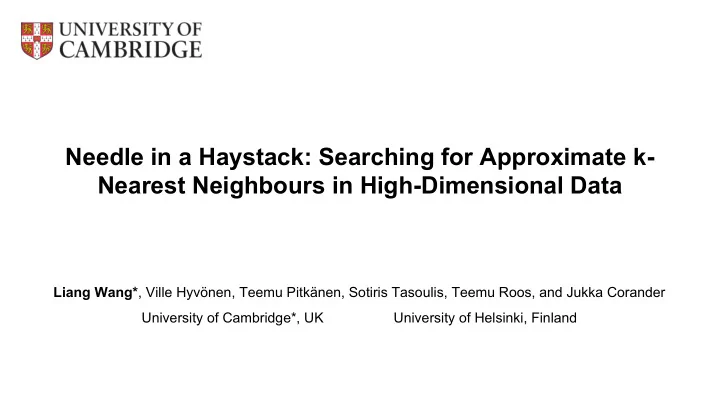

Needle in a Haystack: Searching for Approximate k- Nearest Neighbours in High-Dimensional Data Liang Wang* , Ville Hyvönen, Teemu Pitkänen, Sotiris Tasoulis, Teemu Roos, and Jukka Corander University of Cambridge*, UK University of Helsinki, Finland
Not Only Tall, But Also Very Fat ● Data grow in both volume and dimensionality. ● Due to the technology advances and modelling techniques. ○ Advances in measuring and monitoring tools. ○ Advances in computation and storage technologies. ○ DNA, stock market, language models: inherently HD models. ● Why do high-dimensional data matter? ○ It is hard to tell what information matters in the beginning. ○ Save everything and leave this problem later or someone else.
Searching Needle(s) in a Haystack ● Searching is among the most important operations. ○ E.g., Computer vision, pattern recognition, natural language processing, online recommenders, and etc. ● Searching is difficult in high-dimensional data. Why? ○ “Under rather general conditions, given a query point, the distance between the nearest and farthest points does not increase as fast as dimensionality.” ○ k-NN quickly becomes unstable in high-dimensional spaces. K. Beyer, et al. "When is “nearest neighbor” meaningful?." Database Theory - ICDT’99 . Springer, 1999.
Key Technique - Approximation ● Approximate the original data set with another one of lower dimensionality by “tolerating some error”, i.e., Dimensionality reduction - e.g., SVD, Random Forest, and etc.
Key Technique - Approximation ● Approximate the exact search results with a “roughly” good ones, especially useful for time-constrained applications. D E + For example, B’s 3-nearest neighbours are A, C B C and D. Instead of returning the exact result, we + A + can return A, C, and E if our application can tolerate certain level of error. By so doing, we are usually able to gain a significant improvement on searching efficiency.
Random Projection ● Essentially, it is all about clustering - similar points should be grouped together, i.e., in a cluster.
Classic Random-Projection Tree In every step, the problem space will be divided into half, then solved separately. It is a typical divide and conquer technique. The split point can be mean value, median, or other more complicated statistics. The leaf node is a cluster of points which are close to each other.
Issues of Classic RP-Tree In general, the accuracy is not very high even for a data set of medium dimensionalities. The accuracy is impacted by two kinds of misclassifications: i.e., B and D; A and C. The process of Index building has only limited parallelism, so not very efficient in practice. Index size is big due to storing high-dimensional vectors in the intermediate nodes.
MRPT - Improve Accuracy ● Increase either leaf size or # of trees, but which is better? combine leaf clusters
MRPT - Improve Index Size ● We do not need to store the actual vector at each node. ● Instead, we can use a random seed to generate on the fly. In a leaf cluster, only the indices of vectors in the original data set are stored.
MRPT - Improve Efficiency ● Current algorithm can be parallelised to some extent, especially when moving towards leaves. ● Can we do better? By maximising the parallelism?
MRPT - Improve Efficiency Blue dotted lines are critical boundaries. The There is no critical boundary. All the projections computations in the child-branches cannot can be done in just one matrix multiplication. proceed without finishing the computation in the Therefore, the parallelism can be maximised. parent node.
Almost Done, Let’s Conclude ● High-dimensional data sets are quite common in practical applications. Efficient and accurate searching is difficult. ● MRPT is a compact data structure which provides approximate k-NN search for high-dimensional big data sets. ● MRPT optimises the index size, searching accuracy, searching efficiency, and parallelism of a building process.
Thank you. Questions?
MRPT - Improve Accuracy ● Increase either leaf size or # of trees, but which is better?
Finally, A Concrete Application of MRPT
Recommend
More recommend